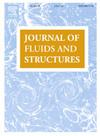用弹性铰接体方法模拟植被在流-丝相互作用中的复杂结构
IF 3.4
2区 工程技术
Q1 ENGINEERING, MECHANICAL
引用次数: 0
摘要
建筑和自然环境中的流体与结构相互作用通常涉及复杂的异质结构。例如,陆生和水生植被物种形态复杂,许多用于理解水流-植被动力学重要方面的模型都没有充分考虑到这一因素。在本研究中,我们开发并验证了一种多体方法,用于模拟流体与复杂组合中的细长结构("细丝")之间的相互作用。这项工作采用费瑟斯通的铰接体算法,允许对连接的细丝组件进行三维模拟。它包括开发一种用于大角度丝状弯曲的弹性模型和一种用于模拟附加质量效应的新型多体方法。通过与线性梁动力学和文献中关于流体-丝线相互作用的三项实验研究进行比较,验证了该模型的能力。这些研究包括:(1) 流动诱导的异质和弯曲长丝的重新配置;(2) 长丝组件的共振和流动诱导的重新配置;(3) 带有附加质量的长丝的波诱导动力学。结果表明,该模型的精确度可与现有的丝状动力学模型媲美,同时将建模能力扩展到多杆集合体。模型的应用结果表明,要准确预测水流与植被的相互作用,就必须表现复杂的形态。本文章由计算机程序翻译,如有差异,请以英文原文为准。

Modelling vegetation as complex structures in fluid–filament interaction using the elastically-articulated body method
Fluid–structure interactions in the built and natural environment commonly involve complex, heterogeneous structures. For example, terrestrial and aquatic vegetation species are morphologically complex, which is a factor not fully captured in many models used to understand important aspects of flow-vegetation dynamics. In this study, we develop and validate a multi-body method for modelling fluid interaction with slender structures (‘filaments’) in complex assemblies. This work uses Featherstone’s Articulated Body Algorithm to permit 3D simulation of connected assemblies of filaments. It includes development of an elasticity model for filament bending at large angles and a novel multi-body method for simulating the added mass effect. The model’s capabilities are validated through comparison with linear beam dynamics and three experimental studies of fluid–filament interaction from the literature. These are (1) flow-induced reconfiguration of heterogeneous and curved filaments, (2) resonance and flow-induced reconfiguration of filament assemblies and (3), wave-induced dynamics of a filament with added mass. The model is shown to be competitively accurate with existing filament dynamics models while extending modelling capability to multi-stem assemblages. Results from the model application demonstrate the importance of representing complex morphologies for accurately predicting flow-vegetation interactions.
求助全文
通过发布文献求助,成功后即可免费获取论文全文。
去求助
来源期刊

Journal of Fluids and Structures
工程技术-工程:机械
CiteScore
6.90
自引率
8.30%
发文量
173
审稿时长
65 days
期刊介绍:
The Journal of Fluids and Structures serves as a focal point and a forum for the exchange of ideas, for the many kinds of specialists and practitioners concerned with fluid–structure interactions and the dynamics of systems related thereto, in any field. One of its aims is to foster the cross–fertilization of ideas, methods and techniques in the various disciplines involved.
The journal publishes papers that present original and significant contributions on all aspects of the mechanical interactions between fluids and solids, regardless of scale.
 求助内容:
求助内容: 应助结果提醒方式:
应助结果提醒方式:


